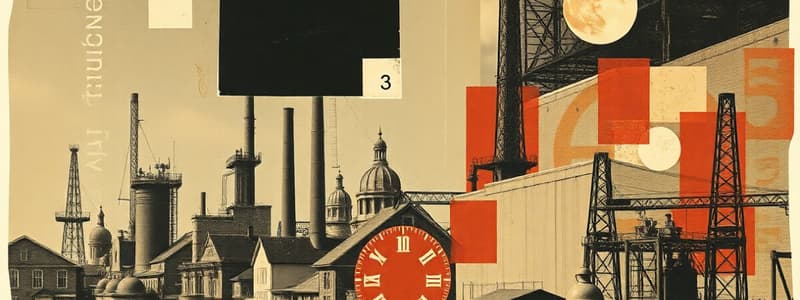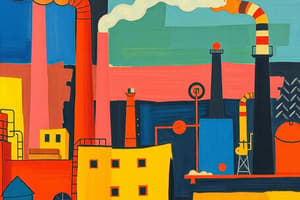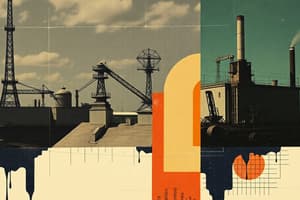Podcast
Questions and Answers
What primary energy sources replaced traditional fuel during the Industrial Revolution?
What primary energy sources replaced traditional fuel during the Industrial Revolution?
- Fossil fuels (correct)
- Water and human power
- Solar energy
- Wood and wind power
What was the significance of guano during the Industrial Revolution?
What was the significance of guano during the Industrial Revolution?
- It served as an essential fertilizer. (correct)
- It was used as a primary fuel source.
- It was a major food source for workers.
- It was a key ingredient in chemical production.
Which advancement contributed to both industry and communication during the 1800s?
Which advancement contributed to both industry and communication during the 1800s?
- Steam locomotives
- Telegraphs (correct)
- Chemical fertilizers
- Mechanical reapers
What was one of the negative environmental impacts of industrialization?
What was one of the negative environmental impacts of industrialization?
Which geographic area was primarily the initial focus of the Industrial Revolution?
Which geographic area was primarily the initial focus of the Industrial Revolution?
What was a direct outcome of the increased production during the Industrial Revolution?
What was a direct outcome of the increased production during the Industrial Revolution?
How did agricultural practices evolve during the Industrial Revolution?
How did agricultural practices evolve during the Industrial Revolution?
What factor contributed to the energy crisis in certain regions during the Industrial Revolution?
What factor contributed to the energy crisis in certain regions during the Industrial Revolution?
Flashcards
What is the Industrial Revolution?
What is the Industrial Revolution?
A period of significant technological advancement and economic growth, characterized by the shift from hand production using animal and human power to machine production using fossil fuels.
What are fossil fuels?
What are fossil fuels?
Energy sources like coal and oil that replaced wood, wind, water, and human/animal power during the Industrial Revolution.
What is guano?
What is guano?
Seabird excrement used as a powerful fertilizer to boost crop production during the Industrial Revolution.
What are some important new technologies that emerged during the Industrial Revolution?
What are some important new technologies that emerged during the Industrial Revolution?
Signup and view all the flashcards
What is economic growth?
What is economic growth?
Signup and view all the flashcards
What is a significant environmental impact of the Industrial Revolution?
What is a significant environmental impact of the Industrial Revolution?
Signup and view all the flashcards
Where did the Industrial Revolution begin, and how did it spread?
Where did the Industrial Revolution begin, and how did it spread?
Signup and view all the flashcards
How did the Industrial Revolution impact the use of resources?
How did the Industrial Revolution impact the use of resources?
Signup and view all the flashcards
Study Notes
Industrial Revolution (1750-1900)
- Energy Crisis: Western Europe, China, and Japan faced a shortage of wood and charcoal.
- Fossil Fuels: The Industrial Revolution relied on fossil fuels like coal and oil, replacing traditional energy sources (wood, wind, water).
- Guano: Europeans used guano (seabird excrement) from islands off Peru as fertilizer.
- Increased Crop Production: This enabled intensive farming practices supporting growing populations in Western Europe, North America, Australia, and New Zealand.
- Technological Advancements: Numerous innovations transformed production, including the steam engine, iron and steel production, railroads and steamships, food processing, and construction.
- 19th Century Innovations: The 1800s saw advancements in chemicals, electricity, precision machinery, the telegraph, telephone, rubber, printing, agriculture (mechanical reapers, chemical fertilizers, pesticides, refrigeration).
- Economic Growth: The industrial revolution led to increased output of goods and services.
- Improved Living Conditions: More wealth generated, extended lifespans, and increased population.
- Environmental Impact: Industrialization negatively impacted the environment. The Thames River in London had a severe pollution problem by 1858.
Key Terms
- Fossil fuels
- Guano
- Steam engine
- Industrial Revolution
- Mechanical reapers
- Chemical fertilizers
- Pesticides
- Refrigeration
- Telegraph
- Telephone
- Rubber
Studying That Suits You
Use AI to generate personalized quizzes and flashcards to suit your learning preferences.




